
Well, this is what we should do: We all should step outside our front doors at the second hour past the time that darkness has settled – on the night of the full Moon – at the top of the hour, and celebrate the full Moon together. Sort of a global, Full Moon Kirtan. Don’t worry you won’t get lost, just let the wind guide you.
HAVE YOU HUGGED YOUR MOON TODAY?
The Moon will be 100% Full: Saturday * August 13, 2011 * 10:57 A.M. Las Vegas time.
From Western Washington University
“American Indians gave names to each of the full moons to keep track of the passing year. The names are associated with the entire month until the next full moon occurs. Since a lunar month averages 29 days, the dates of the moons change from year to year. Here are titles most closely associated with calendar months.”
Two Native tribes are mentioned here – click the WWU link to access more information.
BACK EAST
Algonquin
Northeast to Great Lakes

According to Western Washington University the Algonquin term for August’s moon is: “micheenee kesos” or “when indian corn is edible.”
OUT WEST
Navajo
Southwest, New Mexico

I couldn’t find a Navajo word for this moon. According to Western Washington University the Comanche (Southern Plains) name for August’s Moon is: “tahma mua” or “summer moon.”
From The Old Farmer’s Almanac
“Historically, the Native Americans who lived in the area that is now the northern and eastern United States kept track of the seasons by giving distinctive names to the recurring full Moons.”
“Each full Moon name was applied to the entire month in which it occurred. These names, and some variations, were used by the Algonquin tribes from New England to Lake Superior.”
According to The Old Farmer’s Almanac, August’s Moon is called: The Full Sturgeon Moon. “Some Native American tribes knew that the sturgeon of the Great Lakes and Lake Champlain were most readily caught during this full Moon. Others called it the “Green Corn Moon ” or the “Grain Moon.”
FullMoon.Info – More about the Full Moon
Visit the main pages of LasVegasBuffetClub.Com/
_____________________________________________________________________________________________________

Writing about Native Americans prompted me to include the following links to a truly great Link, LINK WRAY, that is – The FATHER OF EDGY, ELECTRIC, EAR-SCRATCHING ROCK & ROLL.
Fred Lincoln “Link” Wray Jr (May 2, 1929 – November 5, 2005)
Minimalist electric-guitar strummer, Link Wray was an All-American, Native-American, innovative, Rock & Roll founder of rough-tough, scratchy, glaring, guitar-technique – featuring THE POWER CHORD – and it was as powerful as the sound of a chain-saw cutting through a Hollywood night. His breakthrough, ground-breaking monster hit from 1958 (with His Ray Men) RUMBLE is perhaps the genesis of Rock & Roll power-guitar on steroids. Link Wray defines R&R cool…
“Part Shawnee Indian, Wray frequently spoke of his ancestry in performances and interviews. Three of the songs he performed bear the names of American Indian tribes: “Shawnee”, “Apache”, and “Comanche.” “Apache” was an instrumental composed by Jerry Lordan, which became a hit in the UK for The Shadows in 1960. Wray recorded a cover of the song 30 years later, which by then was also associated with everyone from The Ventures to the Incredible Bongo Band” more from WIKI
LVBC note: The WIKI page downplays the fact that a guy by the name of Jørgen Ingmann [a musician from Copenhagen, Denmark] recorded Apache in 1961, which climbed to #2 on the US charts, the only charts that really matter, according to some. Apache was among the first records to use sophisticated electronic recording techniques, if not the first. An afterthought reminds me that Santo and Johnny’s SLEEPWALK preceded APACHE by a few years (1959.) Sleepwalk is probably my favorite all-time guitar instrumental.
Also from WIKI
“Wray served a hitch in the US Army and was a veteran of the Korean War, where he contracted tuberculosis that ultimately cost him a lung. His doctors told him that he would never sing again, so Link concentrated on his heavy guitar work. Despite this, on his rare vocal numbers he displays a strong voice and a range equivalent to that of Clarence “Frogman” Henry’s.”
Here’s the complete song from the 45 (45 RPM record) with minimal video:
This is a clip of an older Wray in concert:
Link Wray was never given proper accolades for this simple, yet staggeringly powerful tune. – BC
Every guitarist could play it because of it’s simplicity, however Link Wray was the innovator.
The song was part of the soundtrack of the film, PULP FICTION.
The electronics-heavy APACHE was also part of this genres foundation. Both songs used cutting-edge electronics such as “tremelo” and echo.
Update August 13, 2011 at 8:00 PM
May as well keep going: Listen to the use of electronics in this early innovation from 1962. Booker T’s guitarist switches on the reverb and everything else in this great foundational mega-hit. When I was up In Northern California, Booker T had a working studio in Sausalito. GREEN ONIONS